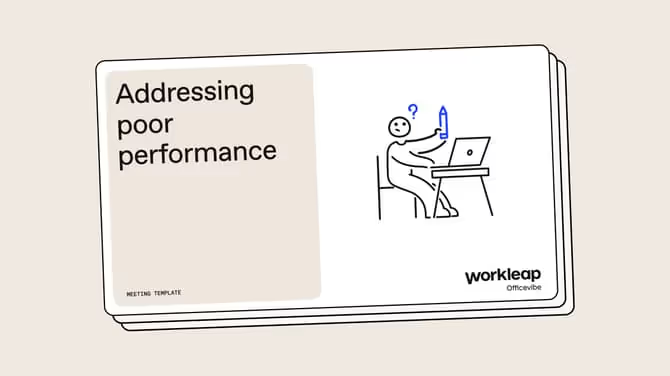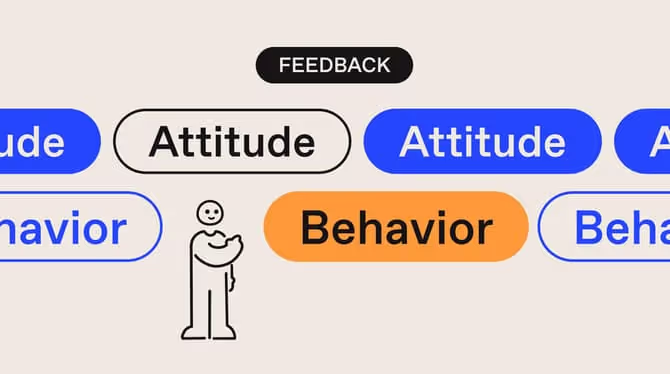The best way to address poor work performance with employees

Discover Workleap Officevibe's benchmark report on 12 key employee engagement metrics

There are always unpleasant parts of a manager’s role, chief among them: addressing poor work performance on your team. As uncomfortable as it is to broach the subject of underperformance, it’s a manager’s job to have these difficult yet formative discussions.
Dont worry! We got you. We have concrete steps to help you deal with underperforming employees as well as tips for preparing your meeting with the poorly performing employee, how to handle the discussion, and what to do afterward.
What is poor work performance?
Poor performance at work is mostly tied to the job's tasks and responsibilities, but can also refer to an employee’s behavior within the team. By definition, poor work performance happens when an employee's performance is below their goals or expectations. Sometimes performance issues are unintentional and can be fixed with solid guidance, while other forms of poor work performance reflect deeper issues such as disengagement and how the employee feels about their job.
How to address poor work performance successfully
Try to address poor work performance sooner rather than later. Talk to your employee in your next one-on-one meeting rather than waiting for a performance review meeting 3 months away.
Here are the steps you can take to ensure your discussion with your underperforming employee is constructive — for both of you.
Before the poor performance conversation
Reflect on the part you played
Ask yourself some reflective questions to see where you might be responsible. If you answer “Yes” to any of these questions, good for you for looking at yourself and being honest. This will help guide the discussion you have, which may be more of a reassessment of the employee’s workload, targets, and role.
- Did I give them too much work?
- Were the targets we set unrealistic?
- Was I not clear enough in defining their role or their tasks?
- Was I not available to them when they needed my guidance?
Give a heads up
Let the employee know you want to have a chat. Agree with them on a time and (virtual) place. Do not take them by surprise.
Check your emotions
If you find you've been frustrated by this employee's poor performance, learn to check those emotions at the door. Don't let negativity set the tone for your talk.
{emphasize}
Remote work tip: Remember that there’s only so much you can see and understand from a distance. Be empathetic to what is going on in the world around the employee, beyond the screen.
{emphasize}
During the poor work performance meeting
Ask and listen
A good manager is a good listener. Attempt to find out if your employee is aware of their poor performance, and have them explain where they think it's coming from. Here are some conversation starters to probe these trickier subjects:
- What’s been going on that you feel might contribute to your performance?
- Do you feel any of my instructions were unclear?
- Were the goals we set unrealistic?
- How have you been feeling at work recently?
- Are you having trouble balancing work and your personal time?
Be specific and concrete
When it comes time to discuss your observations, don't give vague criticisms. Have concrete examples of poor performance to point out.
Create an action plan
Do this collaboratively with the employee so it feels like a solution rather than a punishment. Ensure the goals set for your employee are measurable and time-bound to track their progression and see if their performance has improved. An action plan is not a vague promise to do better, but a clear laying-out of objectives.
{emphasize}
Poor work performance action plan checklist:
✅ Description of the problem: Be extremely clear and specific.
✅ Objectives to solve the problem: Set 1-3 performance goals with the employee.
✅ How progress will be assessed: Define how you'll measure improvement.
✅ Structured deadlines: Set the intervals where progress will be measured.
✅ Manager's role in the action plan: Identify the areas where you'll support the employee.
{emphasize}
{emphasize}
Officevibe's goals and OKRs tool helps managers and employees set and track result-oriented goals that align with teams and company objectives.
{emphasize}
Ask for feedback
See if they agree with your feedback, or if they had issues with how you handled it. Let them know they can speak freely, without fear of negative repercussion.
- Do you agree with the underperforming work examples brought forward?
- Do you feel like the feedback I gave you is helpful?
{emphasize}
Remote work tip: If using video conferencing, pay attention to details like body language.
{emphasize}
After the poor performance discussion
Reach out
Write a friendly email to your employee the next day. Thank them for their time and for sharing their feedback, and add the key points of the discussion as a reminder.
Keep on schedule
Stick to planned follow-ups and consistent performance reviews. This removes any nerves about a surprise check-up. It also demonstrates that you're interested in your employee's development and growth.
Recognize and praise
Be quick to offer recognition messages when you do see progress, especially when it's related to their efforts to improve their performance issues.
{emphasize}
Remote work advice: It’s hard to make sure the employee doesn’t slip again when working from home. You’ll have to increase your pings and emails (psst… use our sample emails to employees to make sure performance stays on the right track). To avoid being overbearing, do these in the morning. Consistency eases the tension of random spot check-ups.
{emphasize}
What are common causes of poor employee performance?
Poor work performance is often a symptom of a larger problem; it is not a core problem in itself. Your job as a manager is to attempt to understand the root cause of underperformance at work.
Here are 3 common causes of poor work performance.
1. Your employee wasn’t properly prepared
The first thing you should investigate is whether poor performance is due to the employee not having the right tools, skills, or instructions. This means that the poor performance wasn't intentional and that the employee could improve.
{emphasize}
Make sure you provide your team with the right tools and guidance. These can be set at the beginning of every new project and be reevaluated along the way.
{emphasize}
2. Poor work performance due to workplace disengagement
Perhaps the employee is feeling unmotivated? Disengaged? Not getting along with their peers? Finding remote work to be difficult? It can also be due to a lack of involvement in decision making, or minimal recognition for their efforts.
{emphasize}
Get to the bottom of this issue by asking your employees the right employee engagement survey questions. Based on the results, you could implement solutions like involving your team in earlier stages of planning, or recognizing their achievements more often.
{emphasize}
3. Your employee is affected by external factors
When you can't locate the source of the problem inside the workplace, you need to consider whether it's a personal problem. This is admittedly the hardest to confront and will require tact and empathy to navigate.
{emphasize}
Be clear that if the employee needs anything — someone to talk to, or some time off to sort things out — your door is always open.
{emphasize}
Leading high-performing teams with empathy
All managers will likely be facing poor employee performance throughout their career. Whether intentional or unintentional, you can rely on the steps provided here to address the issue with confidence and put your employee back on the road to success.
On top of the advice given here about how to deal with a poorly performing employee, there's one more key tool in the performance management kit: emotional intelligence.
Starting from a position of empathy will let your team know that you have their best interest at heart, even when you need to call out the occasional poor work performance.
Give HR and managers the clarity, confidence, and connection to lead better every day.


%20(1).avif)


.avif)
.avif)

.png)

%202.avif)




